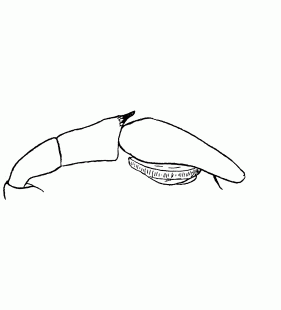Micaria funerea Simon, 1878
Description
Male
Leg I without black-brown spot distal-prolateral on light ground. Palp: cymbium with 4 bristles. Tibia mostly with one apophysis, rarely with two, distal apophysis slender and straight. Retinaculum positioned in longitudinal axis of bulb. Prosoma length: 2.0 mm, prosoma width: 1.4 mm.
Body length male: 4.3 mmFemale
Femur I-II dorsally with one basal bristle, III-IV dorsally with 2 two bristles. Tibia I-II ventrally without long bristles, only with scopula. Epigyne: with blackened anterior margin with sharp lateral edges and pointing partially to openings of Vulva. Two paramedian, parallel longitudinal ridges, strongly sclerotized. Prosoma length: 1.5 mm, prosoma width: 1.1 mm.
Body length female: 4.2 mmDistribution
Distribution List
"No references" does not mean that the species does not occur in this country, but that we have not yet inserted the reference for it. We are working on it.
References
Blagoev G, Deltshev C, Lazarov S, Naumova M (2018) The spiders (Araneae) of Bulgaria. Version: August 2018. National Museum of Natural History, Bulgarian Academy of Sciences. Online at http://www.nmnhs.com/spiders-bulgaria/ (accessed on 10.9.2018) ![]()
Branco V V, Morano E, Cardoso P (2019) An update to the Iberian spider checklist (Araneae). Zootaxa 4614: 201-254 ![]()
Le Peru B (2007) Catalogue et répartition des araignées de France. Revue Arachnologique 16: 1-468 ![]()
Otto S (2022) Caucasian spiders. A faunistic database on the spiders of the Caucasus Ecoregion. Database version 02.2022. Internet: caucasus-spiders.info.
Pantini P, Isaia M (2019) Araneae.it: the online catalog of Italian spiders, with addenda on other arachnid orders occurring in Italy (Arachnida: Araneae, Opiliones, Palpigradi, Pseudoscorpionida, Scorpiones, Solifugae). Fragmenta Entomologica 51: 127-152 ![]()
Simon E (1932) Les arachnides de France 6 (4). Paris (Roret): 773-978 ![]()
WSC (2025) World Spider Catalog. Version 26. Natural History Museum Bern, online at http://wsc.nmbe.ch (28.2.2025) doi: 10.24436/2 ![]()
Updates
| 13-06-2016 | Datasheet update | Detail |

